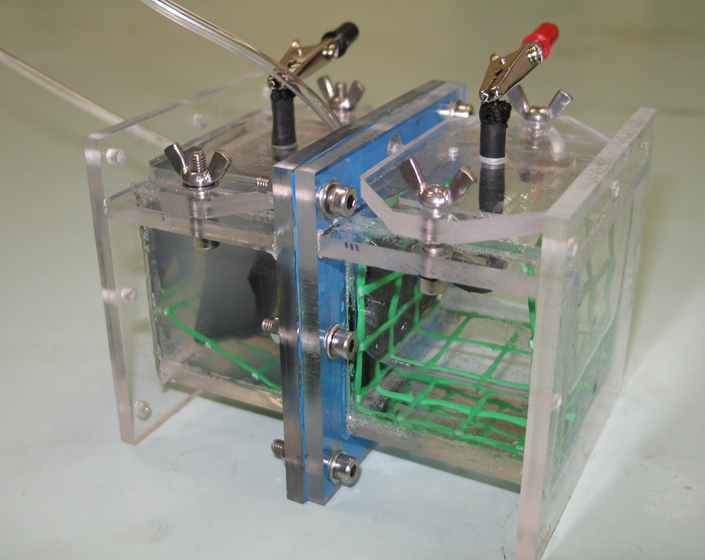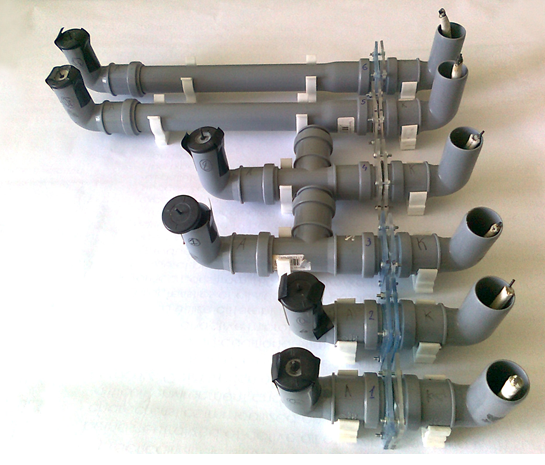Abstract
The development of bioenergy led to the emergence of a fundamentally new source of energy: a microbial fuel cell (MFC). The technical basis of the microbial fuel cell is the electrodes and the proton exchange system that together form the fuel cell, a device that generates electricity with the possibility of regularly adding bio-oxidizable substrates. The biological basis of the MFC is bacteria located in the anode chamber, capable of assimilating substances - energy sources with the subsequent transfer of electrons to the external electric circuit. MFC technology is an example of an interdisciplinary research in which biologists, chemists, physicists and mathematicians are involved. Many stages of the study, such as the experimental study of the current-voltage characteristics of MFC, take several months of work. Without a broad involvement of academically interested students, it is impossible to cope with these tasks. Of great importance in these studies is the involvement of young people in scientific research. The students made a great contribution to the project implementation, taking part in all stages of its implementation. As a result of the research work carried out by the interdisciplinary professor-student team of KubSU, new microbial fuel cells were obtained that characterized by an altered design. Students of various specialties acquired experience in research work in a large team. This can serve as a good start to their scientific career.
Keywords: Microbial fuel cellalternative energystudents’ research team
Introduction
The development of the technology of microbial fuel cells (MFC) is associated with close attention to alternative electrical energy sources. The microbial fuel cell has a family of properties that characterize it as a bioelectrochemical generator. Absence of moving parts and aggressive environments determines a large (years) resource of autonomous operation of devices, which compensates for their small specific power (Chandrasekhar, 2018 ; Logan, 2006b; Kim, 2007; Logan, 2015).
In KubSU, work on microbial technologies for alternative energy was launched in 2012 as part of the University's Strategic Development Program. From the very beginning, students were involved in the work. They took part in the design and manufacture of various types of MFC, experimental and theoretical studies. The results were reported at conferences, included in the articles, became the basis for course and graduate work of bachelors and masters theses.
In this paper, we present the results of a study of the effect of the membrane-type MFC (Logan, 2006a) geometry on the generation of an electric current.
Problem Statement
Microbial fuel cells are electrochemical generators that work by biogenic creation of a potential difference on electrodes located in chambers filled with liquid on different sides of the ion-selective membrane (Fig.

The magnitude of the electric current depends on a number of factors that differ in the degree of influence on the
Research Questions
Two-chamber membrane type MFC was designed (Fig.

The anode and cathode chambers had a cylindrical shape of the same diameter and different lengths. The volume of the cathode chambers of all cells was the same and amounted to 54 ml. The volume of the anode chambers varied from 54 to 230 ml. The length of the anode chambers determined the distance from the anode to the membrane. An ion-selective membrane of area 3.14 cm2 was used to separate the chambers. The chambers were filled with an aqueous solution of salts simulating a sewage water of the following composition:
NaHCO3 – 480 mg;
NH4Cl – 95.5 mg;
K2HPO4 - 10.5 mg;
KH2PO4 – 5.25 mg;
CaCl2 · 2H2O– 63.1 mg;
MgSO4 · 7H2O – 19.2 mg;
water – 1 l.
The anode and the cathode are made of a fibrous inert carbon material. They are placed in the anode and cathode chamber, respectively. All electrical conductors of the experimental cell, in contact with the liquid, were completely made of nonmetallic materials (graphite). The developed surface of the anode and cathode facilitated more efficient anode colonization by the microflora in the anode chamber. A sample of bottom sediments of a freshwater pond containing a wide spectrum of representatives of heterotrophic microflora, predominantly anaerobic or facultative anaerobic, was introduced into the anode chamber. It is proved that these anaerobic biotopes contain an electrogenic microflora. As a substrate for bacteria, glucose was added to the anode chamber at a concentration of 1 g / l. An external load was connected to the external circuit - a resistor with a resistance of 1.1 kΩ.
The experimental problem was formulated as follows: compare the dependence of the current amperage generated by the MFC on the distance between the anode and the ion-selective membrane and, correspondingly, the dependence on the volume of the anode chamber. The characteristics of the MFCs under study are given in Table
Purpose of the Study
The main objectives of the study are
Development of the most effective MFC designs.
Evaluation of the dynamics of the MFC state and ways to extend the effective work time.
Exit to the introduction of MFC in the economy of the region.
Creation of scientific and technical base (student laboratories, professional laboratories) for large-scale research in the field of alternative energy and bio-technologies.
The carried out studies made it possible to determine the time of MFC output to the maximum power and optimize the size of the anode and cathode chambers to increase the power of the MFC.
Research Methods
Experimental studies that lasted more than 600 hours were carried out. In the course of the experiment, the potential difference was measured at the poles of the resistor, over which the magnitude of the current was calculated.
In addition, theoretical studies were carried out. For this purpose, a mathematical model of the membrane type MFC was proposed based on averaging over the volume of the cathode and anode chambers. The proposed model takes into account:
the electrodiffusion processes occurring in the anodic and cathodic chamber,
the release of charge from the bottom sediments,
the process of consuming the organic substrate,
the process of changing the total mass of the bacteria.
The mathematical model is a Cauchy problem for a system of ordinary differential equations [1].
Findings
The professor-student team established experimentally the dependence of the MFC's volt-ampere characteristics on the time and the geometry of the MFC chambers. It turned out that it is most effective to use a small anode chamber and a large cathode chamber. A mathematical model of bio-electric processes in MFC was also created, which confirmed the conclusions on the basis of experiments. Due to the complexity of the biological processes occurring in MFC, the mathematical model and experimental data do not exactly match each other. However the qualitative coincidence of the results of full-scale and numerical experiments confirms the adequacy of the proposed mathematical model and the possibility of its application for studying the processes occurring in MFC.
In particular, in order to test the hypothesis on the cause of the initial surge of current in the mathematical model, the possibility of accounting the residual charge was introduced. Calculations with accounting the residual charge also lead to an initial burst of current strength, independent of the geometry of the MFC chambers. If the residual charge was not taken into account, such a surge in numerical experiments was absent.
Conclusion
The use of biological fuel cells for the production of electrical energy by means of a biochemical reaction might be a promising technologies. Of greatest interest today are microbial fuel cells, which use whole microorganisms as catalysts.
Research and technological development of different types and designs of MFC are conducted with the aim of increasing their efficiency, creating on their basis various technical devices. The duration of one experimental cycle can take dozens of days, which makes the combination of experimental studies and methods of mathematical modeling especially important for such studies.
Thus, MFC technology leads to the need for interdisciplinary research, which involves representatives of different scientific disciplines, which serves as a guarantee of obtaining innovative results. Participation in these studies can be appreciated by students, acquiring an interdisciplinary horizon and skills of independent scientific work.
Acknowledgments
The work was carried out within the framework of the state task of the Ministry of Education and Science, project No. 8.2321.2017 “Development and adaptation of control systems for compensation of dynamic deflecting effects on mobile objects in a state of dynamic equilibrium”.
References
- Chandrasekhar, K., Kadier, A., Kumar, G., Nastro, R. A., & Jeevitha, V. (2018). Challenges in microbial fuel cell and future scope. In Microbial Fuel Cell (pp. 483-499). Springer, Cham.
- Kim, B. H., Chang, I. S., & Gadd, G. M. (2007). Challenges in microbial fuel cell development and operation. Applied microbiology and biotechnology, 76(3), 485.
- Logan, B. E., Wallack, M. J., Kim, K. Y., He, W., Feng, Y., & Saikaly, P. E. (2015). Assessment of microbial fuel cell configurations and power densities. Environmental Science & Technology Letters, 2(8), 206-214.
- Logan, B. E., Hamelers, B., Rozendal, R., Schröder, U., Keller, J., Freguia, S., ... & Rabaey, K. (2006a). Microbial fuel cells: methodology and technology. Environmental science & technology, 40(17), 5181-5192.
- Logan, B. E., & Regan, J. M. (2006b). Microbial fuel cells – challenges and applications.
Copyright information

This work is licensed under a Creative Commons Attribution-NonCommercial-NoDerivatives 4.0 International License.
About this article
Publication Date
23 November 2018
Article Doi
eBook ISBN
978-1-80296-048-8
Publisher
Future Academy
Volume
49
Print ISBN (optional)
-
Edition Number
1st Edition
Pages
1-840
Subjects
Educational psychology, child psychology, developmental psychology, cognitive psychology
Cite this article as:
Ryadchikov, I., Samkov, A., Volchenko, N., Drobotenko, M., Biryuk, A., & Svidlov, A. (2018). Research On Microbial Technologies For Alternative Energy In University Educational Process. In S. Malykh, & E. Nikulchev (Eds.), Psychology and Education - ICPE 2018, vol 49. European Proceedings of Social and Behavioural Sciences (pp. 594-598). Future Academy. https://doi.org/10.15405/epsbs.2018.11.02.67

